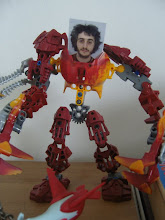On my way to geek martyrdom (PhD viva approaching) I'm finding myself becoming increasingly interested in fractal functions.
Here's my first attempt at coding a fractal in Matlab, which was done on my lunchbreak today.
It's based on a tiny part of the Mandelbrot set, which I've still not fully read into yet (I'm impatient!).
Here's the code, I told you it was simple! So simple in fact that it..soon...becomes.....pretty..........slow.............
clc % clear command window
clf % clear figure
z_old = 0-0i; % Some random value to initialise z_old
for (seed = 0.01:0.005:0.2) % For all these values
disp(seed) % Display seed (not the right term)
z0 = -seed - 0.54i; % The juicy bit
z = 0; % Start here
rndclr=[rand, rand, rand]; % random line colour
for (i = 1:1:50) % number of iterations per seed
z = z^2 + z0; % iteration for the nation
%disp(z);
figure(1)
hold on % don't delete old lines
title(i) % display iteration
plot(z,'.','color',[0,0.1,0]); % draw a point
if (i>1) % if point has a predecessor, connect them together
line([real(z),real(z_old)],[imag(z),imag(z_old)],'Linesmoothing','on','color',rndclr)
end
z_old = z; % Store last point
end
end
Tuesday 17 May 2011
Friday 6 May 2011
3D Graph, meet 3D Printer
So awhile back I ran a stand on robotics and my PhD resarch at a Bristol University public engagement event Changing Perspectives.
One of the most visually assertive parts of my research in robotic movment have been the 3 dimensional plots I use to represent effort considerations in reaching motions. The idea is that the workspace of the robot makes up 2 axis on the graph, while the other axis represents the effort (a combination of graviational and muscular considerations). When planning movements to vertical targets, the robot can aim to keep it's trajectory in the lower parts of the graph, thus reducing effort during movement, as in casual human motion.
Some people find the concept of a 3D graph quite hard to grasp, which is fair enough, so I decided that a nice way to engage the public would be to make the graph tangible. Hence I had it 3D printed.
To make it more inutitive I then created a contour 'heat' map of the simulation, which I projected onto the surface. This meant that points of high effort were highlighted with 'hot' colours, while low regions were coloured with colder shades of blue. Really this could of done with some projection mapping, but I didn't have much time.
Finally, I simulated the robot moving accross the surface in real-time to give the whole thing some motion and context. Unfortunately I was too busy chatting to the visitors to get a video of the projection on the graph, so here's the raw video:
One of the most visually assertive parts of my research in robotic movment have been the 3 dimensional plots I use to represent effort considerations in reaching motions. The idea is that the workspace of the robot makes up 2 axis on the graph, while the other axis represents the effort (a combination of graviational and muscular considerations). When planning movements to vertical targets, the robot can aim to keep it's trajectory in the lower parts of the graph, thus reducing effort during movement, as in casual human motion.
Some people find the concept of a 3D graph quite hard to grasp, which is fair enough, so I decided that a nice way to engage the public would be to make the graph tangible. Hence I had it 3D printed.
To make it more inutitive I then created a contour 'heat' map of the simulation, which I projected onto the surface. This meant that points of high effort were highlighted with 'hot' colours, while low regions were coloured with colder shades of blue. Really this could of done with some projection mapping, but I didn't have much time.
Finally, I simulated the robot moving accross the surface in real-time to give the whole thing some motion and context. Unfortunately I was too busy chatting to the visitors to get a video of the projection on the graph, so here's the raw video:
The Question in Disability Now
Despite many things happening in the last few months (such as handing in my thesis), I've been very poor at updating this blog.
Here's a link to an article on The Question I just discovered in the magazine Disability Now. The Question was a collaborative piece I did with Extant last summer, where we developed the Haptic Lotus.
Here's a snippet from the full story:
Arguably one of Extant’s most breathtaking (and currently on-going) works to date, The Question (2009/2010) utilises the Live Art concept with open arms. It has everything: the tactile audience experience, the walk-through installation, the use of audio and live performers.
Here's a link to an article on The Question I just discovered in the magazine Disability Now. The Question was a collaborative piece I did with Extant last summer, where we developed the Haptic Lotus.
Here's a snippet from the full story:
Arguably one of Extant’s most breathtaking (and currently on-going) works to date, The Question (2009/2010) utilises the Live Art concept with open arms. It has everything: the tactile audience experience, the walk-through installation, the use of audio and live performers.
Labels:
Disability,
Extant,
Haptic Lotus,
Publications,
The Question
Subscribe to:
Posts (Atom)






